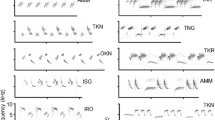Summary
The possibility that the hypotheses of character convergence and character displacement might explain interspecific variation in song features among North American tanagers is examined. Scarlet and summer tanagers (Piranga olivacea and P. rubra) are the most sympatric among the four species and have the largest differences in song characteristics. However, songs of scarlet tanagers do not differ significantly between sympatry and allopatry. Songs of summer tanagers more resemble those of scarlet tanagers in allopatry, but this geographical variation has been explained by variation in habitat characteristics. Both species countersing in sympatry, and react aggressively to each other's songs in sympatry as well as in allopatry, probably due to similarities in the song. The limited data from the narrow sympatric zone between western and hepatic tanagers (P. ludoviciana and P. flava) indicate that their songs differ to a great extent. Therefore, the results do not support the hypothesis of character convergence. Character displacement might explain partially interspecific differences in song features between scarlet and summer tanagers but cannot be tested further.
Similar content being viewed by others
References
Armstrong EA (1973) A study of bird song. Dover, New York
Bent AC (1958) Life histories of North-American blackbirds, orioles, tanagers, and allies. Dover, New York, pp 466–509
Blair WF (1963) Acoustic behaviour of the Amphibia. In: Busnel RG (ed) Acoustic behaviour of animals. Elsevier, Amsterdam, pp 694–708
Brown RN (1977) Character convergence in bird song. Can J Zool 55:1523–1529
Brown RN, Lemon RE (1979) Structure and evolution of song form in the wrens Thryothorus sinaloa and T. felix. Behav Ecol Sociobiol 5:111–131
Brown WL, Wilson EO (1956) Character displacement. Syst Zool 5:49–65
Catchpole CK (1972) A comparative study of territory in the reed warbler (Acrocephalus scirpaceus) and the sedge warbler (A. schoenobaenus) J Zool (Lond) 166:213–231
Catchpole CK (1977) Aggressive responses of male sedge warblers (Acrocephalus schoenobaenus) to playback of species song and sympatric species song, before and after pairing. Anim Behav 25:489–496
Catchpole CK (1979) Vocal communication in birds. Arnold, London
Cody ML (1969) Convergent characteristics in sympatric populations: A possible relation to interspecific territoriality. Condor 71:222–239
Condor ML (1973) Coexistence, coevolution and convergent evolution in seabird communities. Ecology 54:31–44
Cody ML (1974) Competition and the structure of bird communities. Princeton University Press, Princeton, NJ
Emlen ST, Oring LW (1977) Ecology, sexual selection, and the evolution of mating systems. Science 197:215–223
Emlen ST, Rising JD, Thompson WL (1975) A behavioral and morphological study of sympatry in indigo and lazuli buntings of the great plains. Wilson Bull 87:145–175
Ferry C, Deschaintre A (1974) Le chant, signal interspécifique chez Hippolais icterina et polyglotta. Alauda 42:289–312
Grant PR (1972) Convergent and divergent character displacement. Biol J Linn Soc 4:39–68
Littlejohn MJ (1959) Call differentiation in a complex of seven species of Crinia (Anura, Leptodactylidae). Evolution 13:452–468
Marler P (1956) The voice of the chaffinch and its function as a language. Ibis 98:231–261
Marler P (1960) Bird song and mate selection. In: Lanyon WE, Tavolga WN (eds) Animal sounds and communication. American Institute of Biological Sciences. Washington, DC, pp 348–367
Marler P, Boatman DJ (1951) Observations on the birds of Pico, Azores. Ibis 93:90–99
Martin AC, Zim HS, Nelson AL (1951) American wildlife and plants: A quide to wildlife food habits. Dover, New York
Miller EH (1982) Character and variance shift in acoustic signals of birds. In: Kroodsma DE, Miller EH (eds) Acoustic communication in birds. Academic Press, pp 253–295
Murray B (1971) The ecological consequences of interspecific territorial behavior in birds. Ecology 52:414–423
Murray BG Jr (1976) A critique of interspecific territoriality and character convergence. Condor 78:518–525
Prescott KW (1965) The scarlet tanager Piranga olivacea. NJ State Mus Invest 2:1–159
Reed TM (1982) Interspecific territoriality in the chaffinch and great tit on islands and the mainland of Scotland: Playback and removal experiments. Anim Behav 30:171–181
Ryan MJ (1980) Female choice in a neotropical frog. Science 209:523–525
Searcy WA (1979) Female choice of mates: A model for birds and its application to red-winged blackbirds (Agelaius phoeniceus) Am Nat 114:77–100
Shy E (1982) Evolution of songs in North American tanagers (Thraupinae: Piranga). Ph D dissertation, Wayne State University
Shy E (1983) The relation of geographical variation in song to habitat characteristics and body size in North American tanagers (Thraupinae: Piranga). Behav Ecol Sociobiol 12:71–76
Shy E (1984) The structure of song and its geographical variation in the scarlet tanager (Piranga olivacea). Am Midl Nat (in press)
Shy E (in press) Songs of summer tanagers (Piranga rubra): structure and geographical variation. Am Midl Nat
Stein RC (1962) A comparative study of songs recorded from five closely related warblers. Living Bird 1:61–71
Thielcke G, Wüstenberg K, Becker PH (1978) Reactionen von Zilpzalp und Fitis (Phylloscopus collybita, Ph. trochilus) auf verschiedene Gesangsformen des Zilpzalps. J Ornithol 119:213–226
Author information
Authors and Affiliations
Rights and permissions
About this article
Cite this article
Shy, E. Sympatry and allopatry of song in North American tanagers. Behav Ecol Sociobiol 15, 189–195 (1984). https://doi.org/10.1007/BF00292974
Received:
Accepted:
Issue Date:
DOI: https://doi.org/10.1007/BF00292974




